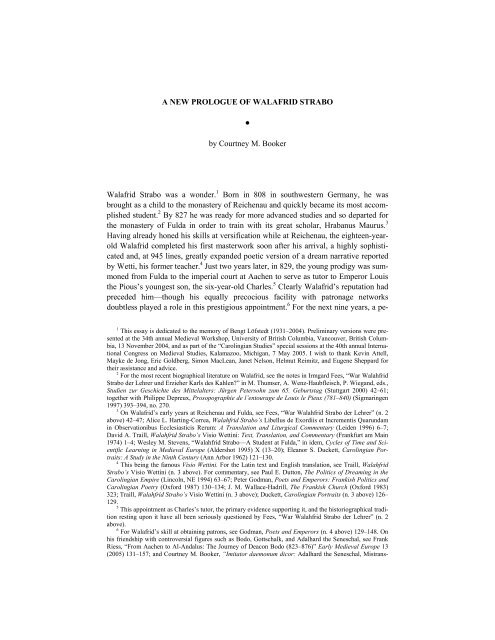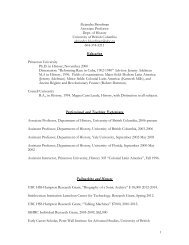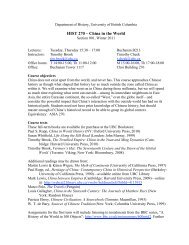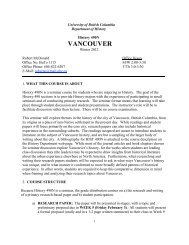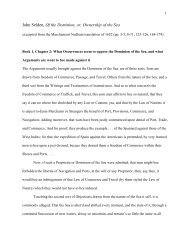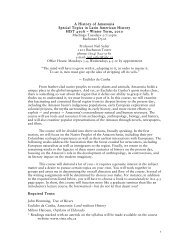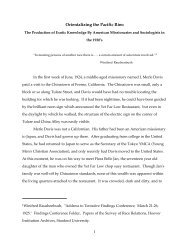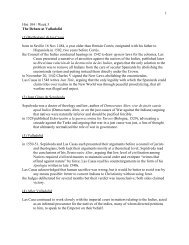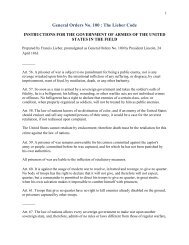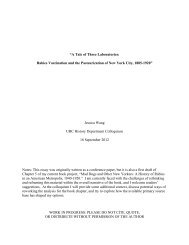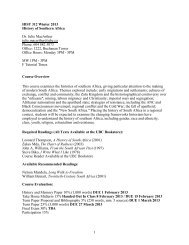A new prologue of walafrid strabo - History, Department of ...
A new prologue of walafrid strabo - History, Department of ...
A new prologue of walafrid strabo - History, Department of ...
You also want an ePaper? Increase the reach of your titles
YUMPU automatically turns print PDFs into web optimized ePapers that Google loves.
A NEW PROLOGUE OF WALAFRID STRABO<br />
●<br />
by Courtney M. Booker<br />
Walafrid Strabo was a wonder. 1 Born in 808 in southwestern Germany, he was<br />
brought as a child to the monastery <strong>of</strong> Reichenau and quickly became its most accomplished<br />
student. 2 By 827 he was ready for more advanced studies and so departed for<br />
the monastery <strong>of</strong> Fulda in order to train with its great scholar, Hrabanus Maurus. 3<br />
Having already honed his skills at versification while at Reichenau, the eighteen-yearold<br />
Walafrid completed his first masterwork soon after his arrival, a highly sophisticated<br />
and, at 945 lines, greatly expanded poetic version <strong>of</strong> a dream narrative reported<br />
by Wetti, his former teacher. 4 Just two years later, in 829, the young prodigy was summoned<br />
from Fulda to the imperial court at Aachen to serve as tutor to Emperor Louis<br />
the Pious’s youngest son, the six-year-old Charles. 5 Clearly Walafrid’s reputation had<br />
preceded him—though his equally precocious facility with patronage networks<br />
doubtless played a role in this prestigious appointment. 6 For the next nine years, a pe-<br />
1 This essay is dedicated to the memory <strong>of</strong> Bengt Löfstedt (1931–2004). Preliminary versions were presented<br />
at the 34th annual Medieval Workshop, University <strong>of</strong> British Columbia, Vancouver, British Columbia,<br />
13 November 2004, and as part <strong>of</strong> the “Carolingian Studies” special sessions at the 40th annual International<br />
Congress on Medieval Studies, Kalamazoo, Michigan, 7 May 2005. I wish to thank Kevin Attell,<br />
Mayke de Jong, Eric Goldberg, Simon MacLean, Janet Nelson, Helmut Reimitz, and Eugene Sheppard for<br />
their assistance and advice.<br />
2 For the most recent biographical literature on Walafrid, see the notes in Irmgard Fees, “War Walahfrid<br />
Strabo der Lehrer und Erzieher Karls des Kahlen?” in M. Thumser, A. Wenz-Haubfleisch, P. Wiegand, eds.,<br />
Studien zur Geschichte des Mittelalters: Jürgen Petersohn zum 65. Geburtstag (Stuttgart 2000) 42–61;<br />
together with Philippe Depreux, Prosopographie de l’entourage de Louis le Pieux (781–840) (Sigmaringen<br />
1997) 393–394, no. 270.<br />
3 On Walafrid’s early years at Reichenau and Fulda, see Fees, “War Walahfrid Strabo der Lehrer” (n. 2<br />
above) 42–47; Alice L. Harting-Correa, Walahfrid Strabo’s Libellus de Exordiis et Incrementis Quarundam<br />
in Observationibus Ecclesiasticis Rerum: A Translation and Liturgical Commentary (Leiden 1996) 6–7;<br />
David A. Traill, Walahfrid Strabo’s Visio Wettini: Text, Translation, and Commentary (Frankfurt am Main<br />
1974) 1–4; Wesley M. Stevens, “Walahfrid Strabo—A Student at Fulda,” in idem, Cycles <strong>of</strong> Time and Scientific<br />
Learning in Medieval Europe (Aldershot 1995) X (13–20); Eleanor S. Duckett, Carolingian Portraits:<br />
A Study in the Ninth Century (Ann Arbor 1962) 121–130.<br />
4 This being the famous Visio Wettini. For the Latin text and English translation, see Traill, Walahfrid<br />
Strabo’s Visio Wettini (n. 3 above). For commentary, see Paul E. Dutton, The Politics <strong>of</strong> Dreaming in the<br />
Carolingian Empire (Lincoln, NE 1994) 63–67; Peter Godman, Poets and Emperors: Frankish Politics and<br />
Carolingian Poetry (Oxford 1987) 130–134; J. M. Wallace-Hadrill, The Frankish Church (Oxford 1983)<br />
323; Traill, Walahfrid Strabo’s Visio Wettini (n. 3 above); Duckett, Carolingian Portraits (n. 3 above) 126–<br />
129.<br />
5 This appointment as Charles’s tutor, the primary evidence supporting it, and the historiographical tradition<br />
resting upon it have all been seriously questioned by Fees, “War Walahfrid Strabo der Lehrer” (n. 2<br />
above).<br />
6 For Walafrid’s skill at obtaining patrons, see Godman, Poets and Emperors (n. 4 above) 129–148. On<br />
his friendship with controversial figures such as Bodo, Gottschalk, and Adalhard the Seneschal, see Frank<br />
Riess, “From Aachen to Al-Andalus: The Journey <strong>of</strong> Deacon Bodo (823–876)” Early Medieval Europe 13<br />
(2005) 131–157; and Courtney M. Booker, “Imitator daemonum dicor: Adalhard the Seneschal, Mistrans-
84<br />
COURTNEY M. BOOKER<br />
riod, he would later recall, “when the state <strong>of</strong> the Franks was battered by many disturbances<br />
and was faltering in many places,” Walafrid remained steadfastly loyal to<br />
Louis and his queen, the much maligned Judith. 7 By 838 the young Prince Charles,<br />
now fifteen, had come <strong>of</strong> age and no longer needed a tutor. Consequently, as a reward<br />
for his years <strong>of</strong> service, Walafrid was made the young abbot <strong>of</strong> his old home, the monastery<br />
<strong>of</strong> Reichenau. 8 He would, however, have little time to savor his success: in 840<br />
another <strong>of</strong> the emperor’s sons, Louis the German, invaded the territory <strong>of</strong> Reichenau,<br />
driving Walafrid into exile. 9 Finding refuge at Speyer, the poet fell back on his extensive<br />
network <strong>of</strong> friends and correspondents, and within two years managed to negotiate<br />
his return to Reichenau in exchange for his loyalty and service to Louis the German.<br />
10 On the eighteenth <strong>of</strong> August, 849, during a diplomatic mission for his <strong>new</strong><br />
king, Walafrid drowned while crossing the Loire. He was only forty years old. 11<br />
What did Walafrid write? He is known mostly for his remarkable poetry, which includes<br />
numerous short works dedicated to friends and patrons, detailed accounts <strong>of</strong><br />
visions, the lives <strong>of</strong> saints, a striking debate with his muse before a statue <strong>of</strong> Theodoric<br />
the Ostrogoth, and a celebrated description <strong>of</strong> the herbs in his garden, all composed in<br />
a vivid and highly nuanced style. But he was also an accomplished author <strong>of</strong> prose,<br />
writing lengthy commentaries on both the Pentateuch and the Psalms, a detailed historical<br />
exposition on the liturgy (now available in an English translation), and still<br />
more lives <strong>of</strong> saints. 12 In 1950 Bernhard Bisch<strong>of</strong>f added yet another set <strong>of</strong> texts to this<br />
lations, and Misrepresentations,” Jahrbuch für internationale Germanistik 33 (2001) 124–126.<br />
7 “cum diversis et multis perturbationibus Francorum res publica fluctuaret et in multis decideret,”<br />
Walafrid Strabo, Prologus to Einhard, Vita Karoli Magni, ed. O. Holder-Egger, MGH SSrG in usum<br />
scholarum (Hanover 1911) XXIX; trans. P. E. Dutton, Charlemagne’s Courtier: The Complete Einhard<br />
(Peterborough 1998) 8. On Walafrid’s relationship with Judith, see Friedrich von Bezold, “Kaiserin Judith<br />
und ihr Dichter Walahfrid Strabo,” Historische Zeitschrift 130 (1924) 377–439; Elizabeth Ward, “Caesar’s<br />
Wife: The Career <strong>of</strong> the Empress Judith, 819–829,” in P. Godman, R. Collins, eds., Charlemagne’s Heir:<br />
New Perspectives on the Reign <strong>of</strong> Louis the Pious (814–840) (Oxford 1990) 221–224; and Walafrid Strabo,<br />
Ad eandem de quodam somnio, ed. E. Dümmler, MGH Poetae Latini Aevi Carolini (Berlin 1884) 2.379–<br />
380, no. 24; trans. K. Langosch, Lyrische Anthologie des lateinischen Mittelalters (Darmstadt 1968) 108–<br />
111.<br />
8 Harting-Correa, Walahfrid Strabo’s Libellus (n. 3 above) 8–10; Traill, Walahfrid Strabo’s Visio Wettini<br />
(n. 3 above) 5–6; Duckett, Carolingian Portraits (n. 3 above) 136–137.<br />
9 Wilfried Hartmann, Ludwig der Deutsche (Darmstadt 2002) 90; Fees, “War Walahfrid Strabo der<br />
Lehrer” (n. 2 above) 48–49; Martina Wiech, Das Amt des Abtes im Konflikt (Siegburg 1999) 153–155; J. F.<br />
Böhmer, E. Mühlbacher, Regesta Imperii: Die Regesten des Kaiserreichs unter den Karolingern 751–918<br />
(1908; Hildesheim 1966) 1.570–571. Alf Önnerfors, Mediaevalia: Abhandlungen und Aufsätze (Frankfurt<br />
am Main 1977) 187, claims that Walafrid fled to Speyer in fall or winter <strong>of</strong> 840. The precise timing <strong>of</strong><br />
Walafrid’s flight is uncertain due to the paucity <strong>of</strong> sources that note it. Many thanks to Eric Goldberg for<br />
help with establishing this chronology.<br />
10 See Boris Bigott, Ludwig der Deutsche und die Reichskirche im ostfränkischen Reich (826–876)<br />
(Husum 2002) 83–84, 97–98, who argues that Walafrid likely returned to Reichenau only in the second half<br />
<strong>of</strong> 842. Paul von Winterfeld, “Nachrichten 180,” Neues Archiv der Gesellschaft für ältere deutsche<br />
Geschichtskunde 27 (1902) 527–528, following a conjecture by Hermann Bloch, suggested, on the basis <strong>of</strong><br />
its library catalogue, that the monastery <strong>of</strong> Murbach also served as a haven for Walafrid during his time <strong>of</strong><br />
exile.<br />
11 Harting-Correa, Walahfrid Strabo’s Libellus (n. 3 above) 10; Traill, Walahfrid Strabo’s Visio Wettini<br />
(n. 3 above) 6–7; Duckett, Carolingian Portraits (n. 3 above) 142–160.<br />
12 For Walafrid’s oeuvre, see K. Langosch, B. K. Vollmann, “Walahfrid Strabo,” in Die deutsche Literatur<br />
des Mittelalters: Verfasserlexikon, 2nd ed. (Berlin 1999) 10.584–603. For the exposition on the liturgy,<br />
see Harting-Correa, Walahfrid Strabo’s Libellus (n. 3 above). Walafrid was long identified erroneously as<br />
the author <strong>of</strong> the Glossa Ordinaria; see Karlfried Froehlich, “Walafrid Strabo and the Glossa Ordinaria:<br />
The Making <strong>of</strong> a Myth,” Studia Patristica 28 (1993) 192–196.
A NEW PROLOGUE OF WALAFRID STRABO 85<br />
impressive corpus when with his incomparable eye he determined that a ninth-century<br />
manuscript in the library <strong>of</strong> Saint-Gall is none other than Walafrid’s personal autograph<br />
notebook, a vademecum crammed with various jottings and extracts <strong>of</strong> texts that<br />
caught the young monk’s interest over the course <strong>of</strong> his short career (much <strong>of</strong> this<br />
material, as Wesley Stevens has since pointed out, relates to astronomy and medicine).<br />
13 Thus, while we do not have an image <strong>of</strong> Walafrid himself, we do have the next<br />
best thing—words from this notebook written by his own hand (fig. 1). 14 As an author<br />
portrait this will have to suffice. Still, it is much more than one can <strong>of</strong>fer for most<br />
other early medieval authors. 15<br />
Walafrid was also an author <strong>of</strong> another sort; that is, he was an avid editor <strong>of</strong> a number<br />
<strong>of</strong> his contemporaries’ works. 16 Not only did he divide into chapters the Life <strong>of</strong><br />
Saint Gall, the Vision <strong>of</strong> Wetti, and the biographies <strong>of</strong> Charlemagne by Einhard and<br />
Louis the Pious by Thegan, but he also provided descriptive chapter titles for some<br />
and wrote short <strong>prologue</strong>s for others. 17 As Walafrid himself explained, he “introduced<br />
titles and chapters ... where they seemed appropriate, so that the reader looking for<br />
13 See Bernhard Bisch<strong>of</strong>f, “Eine Sammelhandschrift Walahfrid Strabos (Cod. Sangall. 878),” in Aus der<br />
Welt des Buches: Festschrift Georg Leyh (Leipzig 1950) 30–48; repr. in B. Bisch<strong>of</strong>f, Mittelalterliche<br />
Studien: Ausgewählte Aufsätze zur Schriftkunde und Literaturgeschichte (Stuttgart 1967) 2.34–51; Wesley<br />
M. Stevens, “Compotistica et astronomica in the Fulda School”; idem, “Walahfrid Strabo—A Student at<br />
Fulda”; idem, “Computus-Handschriften Walafrids Strabo,” all in W. M. Stevens, Cycles <strong>of</strong> Time and Scientific<br />
Learning in Medieval Europe (Aldershot 1995) IX (43–49); X (13–20); XI (363–378). For a critique<br />
<strong>of</strong> Bisch<strong>of</strong>f’s attribution <strong>of</strong> this manuscript to Walafrid, see Paul G. Schmidt, “Karolingische Autographen,”<br />
in P. Chiesa, L. Pinelli, eds., Gli autografi medievali: Problemi paleografici e filologici (Spoleto 1994) 137–<br />
148; together with the qualifications by Hartmut H<strong>of</strong>fmann, “Autographa des früheren Mittelalters,”<br />
Deutsches Archiv für Erforschung des Mittelalters 57 (2001) 32–35.<br />
14 For another alleged autograph by Walafrid (Copenhagen, Det Kongelige Bibliotek, GkS 444 2˚), see<br />
Veronika von Büren, “Une édition critique de Solin au IX e siècle,” Scriptorium 50 (1996) 40–42.<br />
15 On autograph manuscripts from the early Middle Ages, see H<strong>of</strong>fmann, “Autographa des früheren<br />
Mittelalters” (n. 13 above) 1–62; Paul Lehmann, “Autographe und originale namhafter lateinsicher Schriftsteller<br />
des Mittelalters,” in idem, Erforschung des Mittelalters: Ausgewählte Abhandlungen und Aufsätze<br />
(Stuttgart 1959) 1.359–381; David Ganz, “‘Mind in Character’: Ancient and Medieval Ideas about the<br />
Status <strong>of</strong> the Autograph as an Expression <strong>of</strong> Personality,” in P. R. Robinson, R. Zim, eds., Of the Making <strong>of</strong><br />
Books: Medieval Manuscripts, Their Scribes and Readers (Aldershot 1997) 280–299; P. E. Dutton,<br />
“Eriugena’s Workshop: The Making <strong>of</strong> the Periphyseon in Rheims 875,” in J. McEvoy, M. Dunne, eds.,<br />
<strong>History</strong> and Eschatology in John Scottus Eriugena and His Time (Louvain 2002) 141–167; Jason Glenn,<br />
“The Composition <strong>of</strong> Richer’s Autograph Manuscript,” Revue d’histoire des textes 27 (1997) 151–189; Paul<br />
Meyvaert, “Problems concerning the Autograph Manuscript <strong>of</strong> Saint Benedict’s Rule,” Revue Bénédictine<br />
70 (1959) 1–21.<br />
16 Walafrid’s editorial work is still in need <strong>of</strong> much study. To date, it has been examined primarily for<br />
the information it provides for identifying and establishing various recensions in the transmission <strong>of</strong> texts,<br />
e.g., Matthias M. Tischler, Einharts Vita Karoli: Studien zur Entstehung, Überlieferung und Rezeption<br />
(Hanover 2001) 1.363–436; and Ernst Tremp, Studien zu den Gesta Hludowici imperatoris des Trierer<br />
Chorbisch<strong>of</strong>s Thegan (Hanover 1988) 112–128. For Walafrid’s practice <strong>of</strong> dividing works into chapters and<br />
assigning them chapter headings, see the brief comments by Harting-Correa, Walahfrid Strabo’s Libellus (n.<br />
3 above) 199–201.<br />
17 For the Vita Sancti Galli, see B. Krusch, ed., MGH SSrM (Hanover 1902) 4.280–337; for the Visio<br />
Wettini, see Traill, Walahfrid Strabo’s Visio Wettini (n. 3 above) and Wallace-Hadrill, The Frankish<br />
Church (n. 4 above) 323; for the Vita Karoli Magni, see Einhard, Vita Karoli Magni, ed. O. Holder-Egger,<br />
MGH SSrG in usum scholarum (Hanover 1911); for the Gesta Hludovici imperatoris, see Thegan, Gesta<br />
Hludovici imperatoris, ed. E. Tremp, MGH SSrG in usum scholarum, separatim editi, 64 (Hanover 1995)<br />
168–175. As Harting-Correa, Walahfrid Strabo’s Libellus (n. 3 above) 200, notes, Walafrid also claimed to<br />
have given chapter titles to Hrabanus Maurus’s commentary on the Pentateuch. On titles and chapter divisions<br />
in general (but without reference to Walafrid), see J.-C. Fredouille, M.-O. Goulet-Cazé, P. H<strong>of</strong>fmann,<br />
P. Petitmengin, eds., Titres et articulations du texte dans les oeuvres antiques (Paris 1997).
86<br />
COURTNEY M. BOOKER<br />
specific topics might find them more easily.” 18 Certainly there are many elements in<br />
these <strong>prologue</strong>s and editorial interventions deserving careful scrutiny. The purpose <strong>of</strong><br />
the present discussion, however, is rather to introduce a <strong>new</strong> prose <strong>prologue</strong> by<br />
Walafrid, which I uncovered while investigating the history <strong>of</strong> an entirely different<br />
text—one that requires a few words <strong>of</strong> explanation.<br />
In the year 833 Charlemagne’s sole surviving son and heir, Emperor Louis the Pious,<br />
was abandoned by his men. Forsaken on a plain known soon thereafter as the<br />
campus mentitus, the Field <strong>of</strong> Lies, Louis was left to the mercy <strong>of</strong> his rebellious sons<br />
and their coterie <strong>of</strong> bishops and counts. Three months later, the emperor agreed to undertake<br />
a public penance by which he might humble himself, quell the divine anger<br />
provoked by his recent <strong>of</strong>fensive behavior, and achieve reconciliation with God. 19<br />
Sometime shortly after this penance, an anonymous ecclesiastic from the rebel party<br />
composed a narrative that details Louis’s many iniquities, justifies the seemingly treasonous<br />
actions <strong>of</strong> the rebellious bishops against him, and formalizes the grave consequences<br />
<strong>of</strong> his penance—namely, the irrevocable forfeiture <strong>of</strong> the throne. 20 Unfortunately<br />
for the rebellious bishops, Louis soon managed to regain his command. Rescued<br />
from his captors within months, the emperor crushed the rebellion and was reinvested<br />
with his regalia by February <strong>of</strong> 835, less than two years after being deserted<br />
and performing his public penance. Moreover, Louis retained control over the empire<br />
for another five years; only his death by illness in the year 840 would wrest it from<br />
him again. 21<br />
Given its damning contents, how then did the rebellious bishops’ narrative <strong>of</strong><br />
Louis’s alleged iniquities ever survive? To my knowledge, no one has investigated the<br />
circumstances <strong>of</strong> this text’s preservation and transmission, despite—or, perhaps, be-<br />
18 “titulos et incisiones, prout visum est congruum, inserui, ut ad singula facilior quaerenti quod placuerit<br />
elucescat accessus,” Walafrid Strabo, Prologus to Einhard, Vita Karoli Magni, ed. Holder-Egger (n. 7<br />
above) XXIX; trans. Dutton, Charlemagne’s Courtier (n. 7 above) 8. Cf. Walafrid’s similar comments in his<br />
<strong>prologue</strong> to Thegan’s text: “Huic opusculo ego Strabo quasdam incisiones et capitula inserui ... ut facilius<br />
volentibus scire singula pateant titulorum compendio,” Walafrid, Prologus to Thegan, Gesta Hludovici<br />
imperatoris, ed. E. Tremp (n. 17 above) 168; and in his <strong>prologue</strong> to his Vita Sancti Galli, “Vitam igitur<br />
sancti confessoris Christi Galli, patroni nostri, cuius corporis thesaurum fidelibus servatis excubiis, sensu<br />
nobilem, scripto degenerem vultis a me lumine rectae locutionis ornari et seriem confusam capitulorum<br />
distingui limitibus,” Walafrid, Vita Sancti Galli, ed. B. Krusch (n. 17 above) 4.281. As Tremp, Studien zu<br />
den Gesta Hludowici imperatoris (n. 16 above) 114, notes, Walafrid is here invoking the tradition <strong>of</strong> the<br />
“accessus ad auctores”; see Edwin A. Quain, “The Medieval Accessus ad auctores,” Traditio 3 (1945) 215–<br />
264.<br />
19 These events are treated in detail in Courtney M. Booker, “Writing a Wrong: The Divestiture <strong>of</strong> Louis<br />
the Pious (833) and the Decline <strong>of</strong> the Carolingians” (Ph.D. diss., University <strong>of</strong> California, Los Angeles<br />
2002). The inveterate, traditional interpretation <strong>of</strong> the events was summed up with precision by Louis Halphen<br />
in his early essay “La pénitence de Louis le Pieux à Saint Médard de Soissons,” in Bibliothèque de la<br />
Faculté des Lettres de Paris XVIII, Troisièmes Mélanges d’histoire du Moyen Age (Paris 1904) 177–185;<br />
repr. in idem, A travers l’histoire du Moyen Age (Paris 1950) 58–66. For an important reinterpretation, see<br />
Mayke de Jong, “Power and Humility in Carolingian Society: The Public Penance <strong>of</strong> Louis the Pious,”<br />
Early Medieval Europe 1 (1992) 29–52; and eadem, “Sacrum palatium et ecclesia: L’autorité religieuse<br />
royale sous les Carolingiens (790–840),” Annales: Histoire, Sciences Sociales 58 (2003) 1243–1269.<br />
20 The text was entitled by its last editors the Episcoporum de poenitentia, quam Hludovicus imperator<br />
pr<strong>of</strong>essus est, relatio Compendiensis, ed. A. Boretius, V. Krause, MGH Capitularia regum Francorum<br />
(Hanover 1897) 2.51–55. For an examination <strong>of</strong> this text, see Booker, “Writing a Wrong” (n. 19 above)<br />
339–453.<br />
21 Janet L. Nelson, “The Last Years <strong>of</strong> Louis the Pious,” in P. Godman, R. Collins, eds., Charlemagne’s<br />
Heir: New Perspectives on the Reign <strong>of</strong> Louis the Pious (814–840) (Oxford 1990) 147–159.
A NEW PROLOGUE OF WALAFRID STRABO 87<br />
cause <strong>of</strong>—the great significance laid upon the event it so vividly documents. 22 In fact,<br />
Louis’s penance in 833 has nearly always been understood as a ruse or drama, a tragicomic<br />
act <strong>of</strong> self-abasement extorted from Louis by scheming, dissimulating bishops<br />
and foisted upon the fickle, if not entirely credulous, populace. 23 In this harsh light, the<br />
bishops’ justificatory narrative has always been seen as a shameful record <strong>of</strong> an even<br />
more shameful intrigue, and thus deserving <strong>of</strong> little attention. To take its contents seriously<br />
would be to risk being embarrassed by, or complicit with, the actions it justifies<br />
and preserves. Such palpable distaste for the bishops’ text is clearly reflected in its<br />
traditional treatment by its many editors. In most <strong>of</strong> the twenty “critical” editions and<br />
reprintings <strong>of</strong> the text, its editors note with indifference that, since there are no longer<br />
any extant manuscript witnesses <strong>of</strong> it to be found, they simply rely on the editio princeps<br />
published by the French jurist Pierre Pithou (1539–1596) in 1588. 24 One wonders,<br />
however, just how hard they really searched. After all, a contemporary <strong>of</strong> Pithou,<br />
the historian Claude Fauchet (1530–1602), claimed in 1601 that the bishops’ narrative<br />
could still be found in ancient libraries, and indeed even printed a version <strong>of</strong> it himself<br />
that differs in an important way from Pithou’s first edition. 25 The great philosopher<br />
and humanist Leibniz (1646–1716) could still make the same claim more than a century<br />
later. 26<br />
22 Cf., for example, the survival <strong>of</strong> the rebellious bishops’ damning narrative with the disappearance <strong>of</strong><br />
the many documents that were produced to record and promulgate the happy <strong>new</strong>s <strong>of</strong> Louis the Pious’s<br />
<strong>of</strong>ficial restoration in February 835: J. L. Nelson, The Annals <strong>of</strong> St-Bertin (Manchester 1991) 32. However,<br />
see Richard Jackson’s argument that one <strong>of</strong> these latter formal texts—namely, the ordo for Louis’s re-coronation<br />
at Metz—served as the model for, and can be detected within, Charles the Bald’s own coronation<br />
ordo <strong>of</strong> 869: R. A. Jackson, ed., Ordines Coronationis Franciae (Philadelphia 1995) 1.87–109; idem, “Who<br />
Wrote Hincmar’s Ordines?” Viator 25 (1994) 31–52. The only allusion to the rebellious bishops’ narrative<br />
during the Middle Ages can perhaps be discerned in an 11th-c. representation <strong>of</strong> the events <strong>of</strong> 833 by Odbert,<br />
Passio Friderici episcopi Traiectensis, cap. 9, ed. O. Holder-Egger, MGH Scriptores (Hanover 1887)<br />
15, pt. 1.348. On this text, see Booker, “Writing a Wrong” (n. 19 above) 200–212, 351–353.<br />
23 See C. M. Booker, “The Demanding Drama <strong>of</strong> Louis the Pious,” Comitatus: A Journal <strong>of</strong> Medieval<br />
and Renaissance Studies 34 (2003) 170–175; and Booker, “Writing a Wrong” (n. 19 above) 1–338.<br />
24 For a convenient handlist <strong>of</strong> editions <strong>of</strong> this text, see Albert Wermingh<strong>of</strong>f, “Verzeichnis der Akten<br />
fränkischer Synoden von 742–843,” Neues Archiv der Gesellschaft für ältere deutsche Geschichtskunde 24<br />
(1899) 489; and Booker, “Writing a Wrong” (n. 19 above) 584–587. For the editio princeps, see Pierre<br />
Pithou, Annalium et historiae Francorum ab anno Christi DCCVIII ad annum DCCCCXC scriptores<br />
coaetanei XII ... (Paris 1588) bk. 2, pp. 136–148, who printed it in chronological order vis-à-vis the other<br />
texts he included in his book. Note the title that Pithou gave the text in his table <strong>of</strong> contents under item no.<br />
XIII, “Acta impiae et nefandae exauctorationis eiusdem Ludovici Imperatoris apud Compendium Anno<br />
DCCCXXII [sic].” See Booker, “Writing a Wrong” (n. 19 above) 247–255, 575–587. By neglecting to acknowledge<br />
Pithou’s editio princeps at all, the most recent edition <strong>of</strong> the text, that <strong>of</strong> 1897 by Boretius and<br />
Krause, follows the earlier MGH edition by G. H. Pertz in 1835. Both editions take their text from the early<br />
17th-c. ed. by Jacques Sirmond, Concilia antiqua Galliae, cum epistolis pontificum, principum constituionibus,<br />
et aliis Gallicanae rei ecclesiasticae monumentis (Paris 1629) 2.560–564. See Booker, “Writing a<br />
Wrong” (n. 19 above) 30 n. 7.<br />
25 Claude Fauchet, Fleur de la maison de Charlemaigne, qui est la continuation des Antiquitez françoises,<br />
contenant les faits de Pépin et ses successeurs depuis l’an 751 jusques à l’an 840, ... (Paris 1601)<br />
232, (bk. 3, chp. 11) “le proces verbal de sa deposition qui se trouve encores es anciennes libraires.” Fauchet<br />
prints a translation <strong>of</strong> the text on pp. 232–237, which carries the reading (on p. 233) “sous l’empire du glorieux<br />
prince Lothaire.” On the significance <strong>of</strong> this reading, see n. 45 below. On Fauchet, see Janet G.<br />
Espiner-Scott, Claude Fauchet: Sa vie, son oeuvre (Paris 1938).<br />
26 Gottfried Wilhelm Leibniz, Annales imperii occidentis Brunsvicenses, ann. 833, cap. 28; ed. G. H.<br />
Pertz, Gottfried Wilhelm Leibniz: Gesammelte Werke, I, 1 (Hanover 1843; repr. Hildesheim 1966) 428,<br />
“Acta exauctorationis (ut vocant) publicavit Petrus Pithoeus, hoc titulo rei congruente in veteribus schedis<br />
superscripto: Quae sequuntur, gesta sunt apud Compendium contra christianissimum imperatorem Ludovi-
88<br />
COURTNEY M. BOOKER<br />
A few years ago, Matthias Tischler and I independently noticed the bishops’ narrative<br />
listed in a modern description <strong>of</strong> an early sixteenth-century manuscript. 27 After<br />
conducting additional research on this manuscript (fig. 2), which belongs to the University<br />
Library <strong>of</strong> Wrocław, Poland, Tischler recently determined that it was copied by<br />
the German humanist Konrad Peutinger (1465–1546) in 1508. 28 Even more remarkable<br />
is Tischler’s determination <strong>of</strong> Peutinger’s source for his manuscript copy. 29 Now,<br />
the Peutinger manuscript currently in Wrocław contains a particularly interesting assemblage<br />
<strong>of</strong> texts. Grouped together are a series <strong>of</strong> annals running from the beginning<br />
<strong>of</strong> the world to the year 818 (the Chronicon de sex aetatibus mundi, Annales Laureshamenses<br />
703–770, Annales regni Francorum 771–818), followed by Thegan’s<br />
Gesta Hludowici bearing Walafrid’s chapter divisions, and then the episcopal narrative<br />
<strong>of</strong> Louis’s penance. 30 What Tischler has recognized is that this is the very same assem-<br />
cum ....” On Leibniz and the events <strong>of</strong> 833, see Booker, “Writing a Wrong” (n. 19 above) 258 nn. 121–122.<br />
27 See Tremp, Studien zu den Gesta Hludowici imperatoris (n. 16 above) 165–166, no. 15; and Tremp,<br />
MGH SSrG (n. 17 above) 35, 48, who describes the contents <strong>of</strong> Wrocław, Biblioteka Uniwersytecka Akc.<br />
1949/397 (olim Steinw. II Fol. 3) dating from 1508, without recognizing that the bishops’ narrative (on fols.<br />
8r–9v) was otherwise extant only in print (i.e., since the 1588 editio princeps by Pithou). On this oversight,<br />
cf. Tischler, Einharts Vita Karoli (n. 16 above) 1.871 n. 927; and Booker, “Writing a Wrong” (n. 19 above)<br />
343 n. 7, 575–587. Over a century and a half earlier, G. A. H. Stenzel, “Erstes Verzeichnis der auf der Central-Bibliothek<br />
in Breslau befindlichen ...,” Archiv der Gesellschaft für ältere deutsche Geschichtskunde 4<br />
(1822) 104, also noted the presence <strong>of</strong> the bishops’ narrative in the Wrocław manuscript in passing, without<br />
comment or analysis. Likewise, W. von Heyd, Die historischen Handschriften der Königlichen öffentlichen<br />
Bibliothek zu Stuttgart (Stuttgart 1889–1890) 1.112, who observed the text’s presence in Stuttgart, Württembergische<br />
Landesbibliothek, Cod. hist. F 243, fols. 17r–21v, without comment. For a <strong>new</strong> critical edition<br />
and translation <strong>of</strong> the bishops’ narrative using the Wrocław manuscript, see Booker, “Writing a Wrong” (n.<br />
19 above) 575–606 ; however, in light <strong>of</strong> the information discussed below, this edition is now in need <strong>of</strong><br />
revision.<br />
28 Tischler, Einharts Vita Karoli (n. 16 above) 1.873–883. As Tischler point outs, Peutinger used this<br />
copy as source material for his unrealized Kaiserbuch project; indeed, Peutinger later copied the bishops’<br />
narrative <strong>of</strong> 833 from this manuscript into his two manuscript compilations <strong>of</strong> assorted Kaiserbuch material<br />
(Stuttgart, Württembergische Landesbibliothek, Cod. hist. F 243, fols. 17r–21v; Augsburg, Staats- und<br />
Stadtbibliothek, 2˚ Cod. 145, fols. 28r–33r). Paul Joachimsen, Geschichtsauffassung und Geschichtschreibung<br />
in Deutschland unter dem Einfluss des Humanismus (Leipzig 1910) 292 n. 46, was the first to<br />
note the significance <strong>of</strong> the appearance <strong>of</strong> the bishops’ narrative in Peutinger’s copies. On Peutinger, see R.<br />
Aulinger, “Konrad Peutinger,” in P. G. Bietenholz, T. B. Deutscher, eds., Contemporaries <strong>of</strong> Erasmus: A<br />
Biographical Register <strong>of</strong> the Renaissance and Reformation (Toronto 1987) 3.74–76; Erich König,<br />
Peutingerstudien (Freiburg im Breisgau 1914); and Joachimsen, Geschichtsauffassung und Geschichtschreibung,<br />
205–209. For a catalogue <strong>of</strong> Peutinger’s library and the presence <strong>of</strong> this manuscript within it,<br />
see H.-J. Künast, H. Zäh, eds., Die Bibliothek Konrad Peutingers: Edition der historischen Kataloge und<br />
Rekonstruktion der Bestände, vol. 1, Die autographen Kataloge Peutingers: Der nicht-juristische Bibliotheksteil<br />
(Tübingen 2003) 396–399.<br />
29 Tischler, Einharts Vita Karoli (n. 16 above) 1.428–429, 431 n. 603, 874–877.<br />
30 While there are several other texts in the manuscript (see parts B and C in the list below) Tischler,<br />
Einharts Vita Karoli (n. 16 above) 1.870–883, shows, on codicological and paleographical grounds, that<br />
they derive from a different source. Moreover, the Divisio regnorum <strong>of</strong> 806 appearing at the end <strong>of</strong> part A<br />
was an addition made during an earlier stage in the transmission <strong>of</strong> the texts in parts A and D, texts that<br />
were once copied together but are now clustered separately through rebinding. For details on the complete<br />
contents <strong>of</strong> Wrocław, Biblioteka Uniwersytecka Akc. 1949/397, and their rearrangement through rebinding,<br />
see Tischler, Einharts Vita Karoli (n. 16 above) 1.870–872. A basic list <strong>of</strong> the manuscript’s contents is supplied<br />
below. The majority <strong>of</strong> these textual witnesses have not been considered in the critical editions <strong>of</strong> the<br />
texts:<br />
A<br />
fols. 3r–8r: Thegan, Gesta Hludowici imperatoris<br />
fols. 8r–9v: Episcoporum de poenitentia ... relatio Compendiensis (833)<br />
fols. 9v–11r: Divisio regnorum (806)
A NEW PROLOGUE OF WALAFRID STRABO 89<br />
blage <strong>of</strong> texts that was once found in a book preserved in the monastery <strong>of</strong> Reichenau<br />
and catalogued sometime between late 840 and 842 by that monastery’s famous librarian<br />
Reginbert. 31 Book number 36 <strong>of</strong> his personal collection contained, according<br />
to Reginbert, a record <strong>of</strong> events spanning the six ages, from creation to the time <strong>of</strong><br />
Charlemagne and his son Louis, and then concluded with “certain opposing decrees”<br />
(quaedam decreta adversantia). 32 Thanks to another, more detailed library catalogue,<br />
we know that Reginbert’s codex 36 was likely still extant at the end <strong>of</strong> the seventeenth<br />
century, but residing 100 kilometers to the south in the monastery <strong>of</strong> Engelberg. 33 According<br />
to this Engelberg catalogue, the Reginbert codex specifically contained a<br />
number <strong>of</strong> annals reaching to the reign <strong>of</strong> Louis the Pious, followed by Thegan’s<br />
Gesta Hludowici, and then “certain decrees <strong>of</strong> crooked bishops” (decreta quaedam<br />
episcoporum contract[orum]). 34 It concluded with Reginbert’s ex-libris verse colo-<br />
B<br />
fols.13r–24r: Marsilius <strong>of</strong> Padua, De translatione imperii<br />
C<br />
fols. 25r–42v: Einhard, Vita Karoli<br />
fols. 42v–56v: Notker Balbulus, Gesta Karoli imperatoris (Bk. I, 1–33)<br />
fols. 56v–61v: Johannes Presbyter, Epistola ad Manuelem<br />
fols. 61v–141v: Robert <strong>of</strong> Saint-Remi, Historia Hierosolymitana<br />
fols. 141v–142r: Epistola patriarchae Hierosolymitani<br />
D<br />
fols. 144r–145v: Chronicon de sex aetatibus mundi<br />
fols. 145v–146r: Annales Laureshamenses (703–770)<br />
fols. 146r–157r: Annales regni Francorum (771–818)<br />
31 Tischler, Einharts Vita Karoli (n. 16 above) 1.428–429, 875–877. On Reginbert and the library <strong>of</strong> Reichenau,<br />
see F. J. Worstbrock, “Reginbert von Reichenau,” in Die deutsche Literatur des Mittelalters: Verfasserlexikon<br />
(Berlin 1989) 7.1112–1114; Rosamond McKitterick, The Carolingians and the Written Word<br />
(Cambridge 1989) 179–182; Karl Preisendanz, “Reginbert von der Reichenau: Aus Bibliothek und Skriptorium<br />
des Inselklosters,” Neue Heidelberger Jahrbücher N.F. (1952–1953) 1–49; idem, “Aus Bücherei und<br />
Schreibstube der Reichenau,” in Die Kultur der Abtei Reichenau (Munich 1925) 2.657–683; Paul Lehmann,<br />
“Die mittelalterliche Bibliothek,” in Die Kultur der Abtei Reichenau (Munich 1925) 2.647–648. The determination<br />
<strong>of</strong> the cataloguing date to the period between 840–842 is more precise than that previously established.<br />
The terminus ante quem <strong>of</strong> 842 is commonly accepted, since Reginbert claims in the title to his<br />
catalogue that he collected its contents up through the abbacy <strong>of</strong> Ruadhelm (838–842, after which Walafrid<br />
succeeded him as abbot) “Incipit brevis librorum, quos ego Reginbertus, indignus monachus atque scriba, in<br />
insula coenobio vocabulo Sindleozes Avva sub dominatu Waldonis, Heitonis, Erlebaldi et Ruadhelmi<br />
abbatum eorum permissu de meo gradu scripsi aut scribere feci vel donatione amicorum suscepi.” See Paul<br />
Lehmann, ed., Mittelalterliche Bibliothekskataloge: Deutschlands und der Schweiz (Munich 1918) 1.257–<br />
258. However, the terminus post quem <strong>of</strong> 20 June 840 can be established through the contents <strong>of</strong> the book in<br />
question. Since it contained the Gesta Hludowici imperatoris by Thegan with Walafrid’s <strong>prologue</strong> (Tischler,<br />
Einharts Vita Karoli [n. 16 above] 1.429, 877) a <strong>prologue</strong> which refers to Louis the Pious as deceased, the<br />
book itself must have been assembled some time shortly after Louis’s death (20 June 840) and subsequently<br />
catalogued by Reginbert while Ruadhelm was still abbot <strong>of</strong> Reichenau, i.e., before Walafrid regained his<br />
abbacy in 842.<br />
32 See Lehmann, Mittelalterliche Bibliothekskataloge (n. 31 above) 1.261, “In XXXVI. libro continentur<br />
sex a mundi principio aetates usque hactenus; postea Karoli, maioris domus Francorum, Pippini senioris ac<br />
filii eius Karoli et Pippini et Karle, filiorum Karoli, deinde, postquam Pippinus ad regem elevatus est, postea<br />
Karoli regis, deinceps gesta Hludovici regis ac imperatoris; ad extremum quaedam decreta adversantia.” On<br />
the “personal” collection <strong>of</strong> books that Reginbert lists (“Incipit brevis librorum, quos ego Reginbertus ...<br />
scripsi aut scribere feci vel donatione amicorum suscepi”), see McKitterick, The Carolingians and the Written<br />
Word (n. 31 above) 181–182; and Preisendanz, “Reginbert von der Reichenau” (n. 31 above) 33–46.<br />
33 Tischler, Einharts Vita Karoli (n. 16 above) 1.429, 876–877; Albert Bruckner, Scriptoria medii aevi<br />
helvetica: Denkmäler schweizerischer Schreibkunst des Mittelalters (Genf 1950) 8.99; and above all, J.<br />
Werner, “Die Reichenauer Reginberthandschrift XXXVI war in Engelberg,” Zentralblatt für Bibliothekswesen<br />
37 (1920) 84, who made the discovery.<br />
34 “Crooked” for contractus is used here in a pejorative sense to suggest something at once both de-
90<br />
COURTNEY M. BOOKER<br />
phon. 35<br />
Although the fate <strong>of</strong> this manuscript after its appearance in the late seventeenthcentury<br />
Engelberg catalogue remains unknown, we do know that Konrad Peutinger in<br />
1508 and Pierre Pithou in 1588 used as their source a late medieval paper copy <strong>of</strong> it—<br />
what Pithou called a chartaceum exemplar—that has, like the Reginbert codex itself,<br />
also since disappeared. 36 Thus, what we are left with in the Wrocław Peutinger manuscript<br />
and the collection <strong>of</strong> texts printed by Pithou may be copies <strong>of</strong> a copy <strong>of</strong> a book<br />
from Reginbert’s personal library in Reichenau.<br />
This is as far as Tischler goes with the identification and history <strong>of</strong> Reginbert’s<br />
formed and perverse. According to J. F. Niermeyer, Mediae latinitatis lexicon minus (Leiden 1997) 267 s.v.<br />
contrahere, it can also be used to connote usurpation.<br />
35<br />
See Bruckner, Scriptoria medii aevi helvetica (n. 33 above) 8.99, who provides the following catalogue<br />
entry:<br />
Chronicon in quo continentur (Perg. 4).<br />
Sex a principio mundi aetates usque in praesens.<br />
Annales Pipini senioris ac ducis.<br />
Annales Karoli filii Pipini ac ducis.<br />
Annales Karolomanni et Pipini filiorum Karoli qui et ipsi duces.<br />
Annales Pipini regis usque ad Karolum.<br />
Annales Karoli regis et imperatoris usque ad Ludovicum regem et imperatorem.<br />
Gesta Ludovici regis ac imperatoris.<br />
Decreta quaedam episcoporum contract.<br />
Metrum heroicum hexametrum:<br />
Magno in honore domini genitricis alme<br />
Sanctorum quoque multorum _____<br />
Condidit hoc corpus _____ adiuta priorum<br />
Cura Reginbertus scriptor _____<br />
Hoc fratrum durare diu salvumque manere.<br />
Etne forte labor pereat confectus ab illo,<br />
Adiurat cunctos domini per amabile nomen<br />
Hoc ut nullus opus cuiquam concesserit extra<br />
Ni prius ille fidem dederit vel denique pignus<br />
Donec ad has sedes quae accepit salva remittat<br />
Dulcis amice gravem scribendi _____ laborem<br />
Tolle, aperi, recita, ne ledas, claude, repone.<br />
On Reginbert’s colophon (in heroic hexameter) and its manuscript witnesses, see E. Dümmler, ed.,<br />
MGH Poetae Latini Aevi Carolini (Berlin 1884) 2.424; and M. M. Tischler, “Reginbert-Handschriften: Mit<br />
einem Neufund in Klostern Einsiedeln,” Scriptorium 50 (1996) 175–183. For an English translation <strong>of</strong> the<br />
colophon, see Duckett, Carolingian Portraits (n. 3 above) 123–124.<br />
36 Werner, “Die Reichenauer Reginberthandschrift” (n. 33 above) 84, notes that the Reginbert codex<br />
does not appear in an Engelberg library catalogue from 1891. On the copy, which Peutinger discovered in<br />
the monastery <strong>of</strong> Petershausen near Constance (as he notes at the end <strong>of</strong> his copy <strong>of</strong> Thegan’s text in both<br />
Stuttgart, Württembergische Landesbibliothek, Cod. hist. F 243, fol. 17r; and Augsburg, Staats- und<br />
Stadtbibliothek, 2˚ Cod. 145, fol. 28r: “Ex Historia Thegani Corepiscopi Treverensis apud Monasterium<br />
Domus Sancti Petri prope Constanciam comperta”), and its resemblance to the mysterious “chartaceum<br />
exemplar” later used by Pithou (Pithou, Annalium et historiae Francorum [n. 24 above] praefatio—a preface<br />
which, according to Louis de Rosanbo, “Pierre Pithou,” Revue du seizième siècle 16 [1929] 306, was<br />
written in 1581, seven years earlier than its publication date), see Tischler, Einharts Vita Karoli (n. 16<br />
above) 1.874–877. Tischler makes a convincing argument that Peutinger’s Petershausen codex and Pithou’s<br />
“chartaceum exemplar” were indeed the same late medieval manuscript, but is careful to note that this identification<br />
cannot be determined with absolute certainty (although he ignores his own caveat on p. 431 n.<br />
603). The fate <strong>of</strong> this lost Petershausen codex is unknown.
A NEW PROLOGUE OF WALAFRID STRABO 91<br />
book and the presence <strong>of</strong> the episcopal narrative within it. Yet it is possible to go still<br />
a few steps further, steps that will lead us back to Walafrid. To begin with, at the top<br />
<strong>of</strong> folio 8r <strong>of</strong> the Wrocław Peutinger manuscript (fig. 2), there is a short, anonymous<br />
<strong>prologue</strong> to the episcopal narrative. Appearing just prior to—and set clearly apart<br />
from—the narrative’s opening words, the <strong>prologue</strong> <strong>of</strong>fers didactic remarks that establish<br />
for the reader how the rebellious bishops’ account should be understood:<br />
Quae sequuntur gesta sunt apud Compendium palatium contra Christianissimum imperatorem<br />
Ludouicum, postquam regno ad tempus privatus est. Acta sunt [autem] studio non<br />
imitandae deiectionis eius ab Hebone auctore eiusdem mali, et caeteris episcopis, vel errore<br />
annitentibus, vel timore consentientibus. Non sunt autem haec ut salubris concilii decreta<br />
amplectenda, sed ut exitialis commenti molimina [respuenda]. 37<br />
[What follows are the things that were done against the most Christian emperor Louis at the<br />
palace <strong>of</strong> Compiègne when he was deprived <strong>of</strong> the kingdom for a time. These things were<br />
done from a partisan zeal for his overthrow, which should not be imitated, by Ebbo, the author<br />
<strong>of</strong> this evil, and by the other bishops who were either working in error or acquiescing<br />
out <strong>of</strong> fear. These things, however, should not be embraced as the decrees <strong>of</strong> a healthy council,<br />
but rejected as the work <strong>of</strong> a deadly contrivance.]<br />
Now, this <strong>prologue</strong> has been seen elsewhere. In fact, it appears as the preface to the<br />
editio princeps <strong>of</strong> the rebellious bishops’ narrative printed in 1588 by Pierre Pithou<br />
(fig. 3). 38 Because scholars could not find any manuscript witnesses that would lead<br />
them to think otherwise, they have always assumed that this editorial <strong>prologue</strong> was<br />
written by Pithou himself. 39 The earlier appearance <strong>of</strong> this same <strong>prologue</strong> in Peutinger’s<br />
manuscript from 1508, however, proves this assumption wrong. It was not<br />
written by Pithou, but copied by him together with the bishops’ narrative from a common<br />
source. What is more, thanks to a fortunate survival, Pithou even tells us who the<br />
author <strong>of</strong> this didactic <strong>prologue</strong> was.<br />
Remarkably, Pithou’s personal copy <strong>of</strong> his book <strong>of</strong> early medieval Frankish texts<br />
published in 1588 still exists, a unique volume containing Pithou’s own addenda and<br />
corrigenda in manuscript to the texts he collected and printed. 40 In its table <strong>of</strong> contents,<br />
37 Wrocław, Biblioteka Uniwersytecka Akc. 1949/397, fol. 8r. The words in brackets are supplied<br />
through collation with the other witness <strong>of</strong> the text, cited in the following note.<br />
38 Pithou, Annalium et historiae Francorum (n. 24 above) bk. 2, p. 136.<br />
39 This is usually a tacit assumption, but for an explicit attribution see Martin Bouquet, Recueil des historiens<br />
des Gaules et de la France (Paris 1749) 6.XIV, cap. XXXV.<br />
40 Paris, Bibliothèque nationale de France, Réserve des livres rares, Res. L45-1: Pierre Pithou, Annalium<br />
et historiae Francorum ab anno Christi DCCVIII ad annum DCCCCXC scriptores coaetanei XII ... (Paris<br />
1588). The book was later owned in succession by Charles Labbe, Étienne Baluze, and D. de Targny, according<br />
to a note on the title page; see also the remarks in Stephanus Baluzius, Capitularia regum Francorum<br />
(Paris 1780) 1.78, regarding volume CII in Baluze’s library. Among the marginalia left by these<br />
various later owners <strong>of</strong> the book, Pithou’s hand is clearly identifiable; cf. the independent observations <strong>of</strong><br />
Léon Pigeotte, Manuscrit autografe du commentaire de Pierre Pithou sur La Coutume de Troyes (Troyes<br />
1872) 7; and Rosanbo, “Pierre Pithou” (n. 36 above) 308, on the recognizably “fine écriture” <strong>of</strong> Pithou. For<br />
a convenient sample <strong>of</strong> his hand, see M.-M. Fragonard, P.-E. Leroy, eds., Les Pithou: Les lettres et la paix<br />
du royaume: Actes du colloque de Troyes, 13–15 avril 1998 (Paris 2003) 304. A handlist <strong>of</strong> extant witnesses<br />
<strong>of</strong> such personal copies by early modern authors unfortunately remains a desideratum, but see Robin C.<br />
Alston, Books with Manuscript: A Short Title Catalogue <strong>of</strong> Books with Manuscript Notes in the British<br />
Library (London 1993) 656–663. For an excellent introduction to the historical value <strong>of</strong> annotated books,<br />
see Helen J. Jackson, Marginalia: Readers Writing in Books (New Haven 2001).
92<br />
COURTNEY M. BOOKER<br />
as item number 12, Pithou lists Thegan’s Gesta Hludowici with Walafrid Strabo’s<br />
<strong>prologue</strong>, followed by item number 13, the “Proceedings <strong>of</strong> the same Emperor Louis<br />
the Pious’s shameful and impious deposition.” 41 At the end <strong>of</strong> the latter entry, one<br />
finds the following postscript, added in Pithou’s own hand: “with a preface by the<br />
same Walafrid” (cum praefatione eiusdem Walafridi) (fig. 4). 42 Similarly, if we turn to<br />
the page containing the preface itself, we see that Pithou simply noted across its top,<br />
“Walafridus Strabo” (fig. 5). 43 In short, it appears that Pithou (or perhaps his printer)<br />
failed to specify in the book’s original printing that Walafrid, the author <strong>of</strong> the <strong>prologue</strong><br />
to Thegan’s text, was also the author <strong>of</strong> the <strong>prologue</strong> to the text immediately<br />
following. Luckily for us, Pithou later made a note to himself <strong>of</strong> this unfortunate slip. 44<br />
There are indeed many, many things <strong>of</strong> interest in Pithou’s personal copy, or Handexemplar,<br />
<strong>of</strong> his book. For the sake <strong>of</strong> example, however, just two will be described<br />
here: a corrigendum and an addendum. First, Pithou corrected a misprint in the<br />
bishop’s narrative, emending the erroneous “super imperio” to read “sub imperio”<br />
(fig. 6). 45 If we turn to the witness <strong>of</strong> this text in the Wrocław Peutinger manuscript,<br />
we find the same correct reading, “sub imperio” (fig. 7). 46 Regrettably, due to the general<br />
indifference <strong>of</strong> editors toward this text, coupled with the fact that Pithou’s erroneous<br />
printed edition was until now the only known source for it, the reading super imperio—despite<br />
its faulty grammar—has been uncritically adopted by some historians<br />
as demonstrative <strong>of</strong> a revolutionary moment in ecclesiastical political ideology—that<br />
41 “Acta impiae et nefandae exauctorationis eiusdem Ludovici Imperatoris apud Compendium Anno<br />
DCCCXXII [sic].” Note that whereas Pithou calls the text “acta,” Walafrid in his <strong>prologue</strong> refers to it as<br />
“decreta,” as do Reginbert and the author <strong>of</strong> the Engelberg catalogue (both likely following Walafrid’s designation<br />
in his <strong>prologue</strong>).<br />
42 Paris, Bibliothèque nationale de France, Réserve des livres rares, Res. L45-1 (n. 40 above) table <strong>of</strong><br />
contents.<br />
43 Paris, Bibliothèque nationale de France, Réserve des livres rares, Res. L45-1 (n. 40 above) bk. 2, p.<br />
136.<br />
44 That this lacuna was not corrected in the second edition <strong>of</strong> Pithou’s book (Frankfurt 1594) may suggest—depending<br />
on the extent <strong>of</strong> his involvement in the publication <strong>of</strong> the second edition—that Pithou<br />
recorded this corrigendum in his Handexemplar sometime between 1594 and his death on 1 November<br />
1596. On early modern book publication and its myriad processes, see David McKitterick, Print, Manuscript<br />
and the Search for Order, 1450–1830 (Cambridge 2003) 97–165; and Percy Simpson, Pro<strong>of</strong>-Reading<br />
in the Sixteenth, Seventeenth, and Eighteenth Centuries (London 1935). In 1601, Fauchet, Fleur de la maison<br />
de Charlemaigne (n. 25 above) 232, printed the <strong>prologue</strong> and the narrative, but believed that both were<br />
written by Thegan: “le proces verbal de sa deposition qui se trouve encores es anciennes librairies, recueilly<br />
par Tegan corevesque (c’est comme evesque rural) de Treves: qui fut present à l’affaire .... l’edict Tegan<br />
commence donc ainsi.” However, following his reproduction <strong>of</strong> the narrative (in which he again names<br />
Thegan as its author, p. 237) Fauchet is suddenly less certain, now curiously naming Walafrid as a possible<br />
author <strong>of</strong> the text (p. 237) “Et voila le proces verbal de la deposition de ce grand empereur, tel que nous la<br />
laissé Tegan, ou Uvallafrid Strabon, autheurs du temps: et qu’il m’a semblé necessaire d’estre incorporé en<br />
ces antiquitez, pour les causes que le mesme Tegan à dit au commencement d’iceluy: et advertir les rois de<br />
n’estre tant superstitieux, que fut ce bon prince.” Clearly Fauchet had before him a manuscript witness <strong>of</strong><br />
the text that in some way led him to believe that Thegan or Walafrid was its author. Similarly, in two manuscript<br />
copies made by Konrad Peutinger (Stuttgart, Württembergische Landesbibliothek, Cod. hist. F 243,<br />
fols. 17r, 21v; Augsburg, Staats- und Stadtbibliothek, 2˚ Cod. 145, fols. 28r, 33r) Peutinger associates<br />
Thegan with the text; in this instance the association is likely due to the fact that the bishops’ narrative followed<br />
directly after Thegan’s text in Peutinger’s source (as attested by the order <strong>of</strong> the two texts in Wrocław,<br />
Biblioteka Uniwersytecka Akc. 1949/397, Peutinger’s copy <strong>of</strong> his now-lost Petershausen exemplar).<br />
45 Paris, Bibliothèque nationale de France, Réserve des livres rares, Res. L45-1 (n. 40 above) bk. 2, p.<br />
138. See n. 25 above for an independent correct reading by Claude Fauchet in 1601.<br />
46 Wrocław, Biblioteka Uniwersytecka Akc. 1949/397, fol. 8r.
A NEW PROLOGUE OF WALAFRID STRABO 93<br />
the haughty bishops in 833 were proclaiming themselves to be set up over the authority<br />
<strong>of</strong> the emperor himself. 47 Second, on a rear flyleaf <strong>of</strong> his Handexemplar, Pithou<br />
copied as an addendum a text that purports to be the actual ordination sermon proclaimed<br />
by Archbishop Boniface <strong>of</strong> Mainz to Charlemagne’s father, Pepin the Short,<br />
in the year 751, a sermon that confirms the replacement <strong>of</strong> the Merovingian royal dynasty<br />
with Pepin and his (Carolingian) heirs at the request <strong>of</strong> the Gallic people. 48 This<br />
text, if authentic, would be a truly remarkable find. Unfortunately, several incongruities,<br />
such as its Latinity, suggest it is spurious. That Pithou provided an illegible marginal<br />
reference to its source only adds to the mystique <strong>of</strong> this admittedly seductive<br />
text. 49<br />
Given the fundamental importance <strong>of</strong> Pithou for our knowledge <strong>of</strong> numerous early<br />
medieval texts, it is extremely regrettable that there are no detailed modern studies <strong>of</strong><br />
him. 50 With only a little effort, one can find truly remarkable things from his pen, such<br />
as a meticulous, heavily annotated copy <strong>of</strong> the famous text by the ninth-century historian<br />
Nithard, a text that contains the earliest appearance <strong>of</strong> the French language (the<br />
Oaths <strong>of</strong> Strasbourg), which has long been known through only one manuscript. 51<br />
Returning to the <strong>prologue</strong> preserved in Reginbert’s book, Pithou’s attribution <strong>of</strong> it<br />
to Walafrid Strabo makes even more sense if we look at the relationships among the<br />
particular texts assembled in the book. The last two works in the volume, Thegan’s<br />
Gesta Hludowici and the bishops’ narrative, both had <strong>prologue</strong>s, and Walafrid identifies<br />
himself within the former. 52 Moreover, both <strong>prologue</strong>s are similar in form and<br />
47 Walter Ullmann, The Carolingian Renaissance and the Idea <strong>of</strong> Kingship (London 1969) 67. The<br />
foundation for this interpretation was already clearly established in Ullmann’s article “The Bible and Principles<br />
<strong>of</strong> Government in the Middle Ages,” in Settimane di studio del Centro italiano di studi sull’alto medioevo<br />
(Spoleto 1963) 10.196–200. It is significant to note that G. H. Pertz was the first and only editor <strong>of</strong> the<br />
text to emend the erroneous “super” to “sub”; see MGH Scriptores (Hanover 1835) 1.366 (though J.-P.<br />
Migne preserved this emendation in his reprint <strong>of</strong> Pertz’s text in PL 97.660D). Equally significant is the fact<br />
that Boretius and Krause chose to retract Pertz’s emendation in their edition <strong>of</strong> 1897; see MGH Capitularia<br />
regum Francorum (n. 20 above) 2.52.<br />
48 Paris, Bibliothèque nationale de France, Réserve des livres rares, Res. L45-1 (n. 40 above) rear flyleaf.<br />
49 I am currently preparing a study <strong>of</strong> this text, “The Alleged Oratio <strong>of</strong> Boniface to Pepin in 751.” It has<br />
been ignored or overlooked by all modern analysts <strong>of</strong> the events <strong>of</strong> 751.<br />
50 The best study is Pierre-Jean Grosley, Vie de Pierre Pithou avec quelques memoires sur son pere et<br />
ses freres (Paris 1756). Modern biographies begin with Louis de Rosanbo, “Pierre Pithou,” Revue du<br />
seizième siècle 15 (1928) 279–305; 16 (1929) 301–330; Donald R. Kelley, Foundations <strong>of</strong> Modern Scholarship:<br />
Language, Law, and <strong>History</strong> in the French Renaissance (New York 1970) 241–270; R. McKitterick,<br />
“The Study <strong>of</strong> Frankish <strong>History</strong> in France and Germany in the Sixteenth and Seventeenth Centuries,” Francia<br />
8 (1980) 559–561; Françoise Bibolet, “Bibliotheca Pithoeana: Les manuscrits des Pithou: Une histoire<br />
de fraternité et d’amitié,” in D. Nebbiai-Dalla Guarda, J.-F. Genest, eds., Du copiste au collectionneur:<br />
Mélanges d’histoire des textes et des bibliothèques en l’honneur d’André Vernet (Turnhout 1998) 497–521;<br />
and M.-M. Fragonard, P.-E. Leroy, eds., Les Pithou: Les lettres et la paix du royaume: Actes du colloque de<br />
Troyes, 13–15 avril 1998 (Paris 2003).<br />
51 Troyes, Bibliothèque municipale, 3203. See the Catalogue général des manuscrits des bibliothèques<br />
publiques de France, vol. 63, Suppléments Dijon, Pau, Troyes (Paris 1984) 134; and Rosanbo, “Pierre<br />
Pithou” (n. 36 above) 308 n. 4. I am currently preparing a study <strong>of</strong> this manuscript, “Per fas et nefas: The<br />
Strange <strong>History</strong> <strong>of</strong> Nithard’s Historiae.” Nithard’s text otherwise survives in Paris, BNF Lat. 9768 (saec. X)<br />
and in an incomplete copy (lacking the Strasbourg Oaths) made in the 15th c., BNF Lat. 14663. On the<br />
fundamental importance <strong>of</strong> Nithard’s text, see R. Howard Bloch, “The First Document and the Birth <strong>of</strong><br />
Medieval Studies,” in D. Holler, ed., A New <strong>History</strong> <strong>of</strong> French Literature (Cambridge, MA 1989) 6–13.<br />
52 Walafrid, Prologus to Thegan, Gesta Hludovici imperatoris, ed. E. Tremp (n. 17 above) 168, “Huic<br />
opusculo ego Strabo ....” Although Wrocław, Biblioteka Uniwersytecka Akc. 1949/397, does not contain<br />
Walafrid’s <strong>prologue</strong> to Thegan’s text, it does include his chapter divisions. Walafrid’s <strong>prologue</strong> to Thegan’s
94<br />
COURTNEY M. BOOKER<br />
content: each describes Louis as “the most Christian emperor” (Christianissimus imperator);<br />
each speaks <strong>of</strong> the zeal possessed by the author <strong>of</strong> the text or actions that<br />
follow 53 ; and each is emphatic that the intention behind a work is more important than<br />
its form, and that an elegant style can <strong>of</strong>ten be used to conceal the truth. 54 If we turn to<br />
the chapter titles that Walafrid assigned to Thegan’s text, the subtle similarities in<br />
syntax, vocabulary, and orthography they bear to the <strong>new</strong> <strong>prologue</strong> only strengthen its<br />
attribution to Walafrid. 55<br />
Indeed, so strong are the ties between the “editions” <strong>of</strong> the bishops’ narrative and<br />
Thegan’s text that I submit that Walafrid himself, as editor, had initially grouped them<br />
for a common didactic purpose. 56 When the two texts are read together as a single unit,<br />
it becomes rather plausible that Thegan’s text serves as a loyalist answer or rebuttal to<br />
the numerous charges in the bishops’ narrative <strong>of</strong> Louis’s iniquity. As Thegan has<br />
Louis explain, using vivid, direct speech, he did not assemble his people together on<br />
the Field <strong>of</strong> Lies for the purpose <strong>of</strong> their mutual destruction—an act which the bishops<br />
themselves had claimed was the emperor’s greatest sin (cumulus miseriarum)—but<br />
rather sent his own faithful men away out <strong>of</strong> concern that they not lose their lives or<br />
limbs on his account. 57 Another commonality between the two texts is their choice <strong>of</strong><br />
text only survives in two witnesses: Copenhagen, Universitätsbibliothek, AM 830 4˚, fol. 97r (dating from<br />
1496); and Pithou’s printed collection <strong>of</strong> sources, Annalium et historiae Francorum (n. 24 above) bk. 2, pp.<br />
93–94 (published in 1588). See Tremp, Studien zu den Gesta Hludowici imperatoris (n. 16 above) 114, 164,<br />
172. For a partial English translation, see Duckett, Carolingian Portraits (n. 3 above) 149. Given the fact<br />
that Pithou provides Walafrid’s <strong>prologue</strong>, it is reasonable to assume that his exemplar—the late medieval<br />
paper manuscript believed also to be Peutinger’s exemplar (the “Petershausen codex”) for Wrocław, Biblioteka<br />
Uniwersytecka Akc. 1949/397—contained the <strong>prologue</strong> as well, and that Peutinger neglected to copy<br />
it (but did note the chapter divisions). See n. 36 above.<br />
53 Prologus to the bishops’ narrative: “Acta sunt autem studio non imitandae deiectionis eius ab Hebone<br />
auctore eiusdem mali, et caeteris episcopis”; Walafrid, Prologus to Thegan, Gesta Hludovici imperatoris,<br />
ed. E. Tremp (n. 17 above) 168, “Praeterea nimius amor iustitiae et executoris eius, christianissimi imperatoris,<br />
zeli naturalis exaggeravit ardorem.”<br />
54 Prologus to the bishops’ narrative: “Acta sunt autem studio non imitandae deiectionis eius ab Hebone<br />
auctore eiusdem mali, et caeteris episcopis, vel errore annitentibus, vel timore consentientibus. Non sunt<br />
autem haec ut salubris concilii decreta amplectenda, sed ut exitialis commenti molimina respuenda”;<br />
Walafrid, Prologus to Thegan, Gesta Hludovici imperatoris, ed. E. Tremp (n. 17 above) 168, “Hoc opusculum<br />
in morem annalium Thegan, natione Francus, Treverensis ecclesiae chorepiscopus, breviter quidem et<br />
vere potius quam lepide composuit .... Unde gratum sit opus eius pro bona voluntate, non fastidiendum pro<br />
quantulacumque rusticitate.”<br />
55 Cf. the <strong>prologue</strong> to the bishops’ narrative with the following chapter titles by Walafrid:<br />
Quae sequuntur gesta sunt apud Compendium palatium contra Christianissimum imperatorem Ludouicum,<br />
postquam regno ad tempus privatus est. Acta sunt autem studio non imitandae deiectionis eius ab Hebone<br />
auctore eiusdem mali, et caeteris episcopis, vel errore annitentibus, vel timore consentientibus. Non<br />
sunt autem haec ut salubris concilii decreta amplectenda, sed ut exitialis commenti molimina respuenda.<br />
X. Quomodo decreta patrum suorum roboraverit (ed. E. Tremp [n. 17 above] 170); XLII. Quae gesta<br />
sunt apud Campum-Mendacii; XLIII. Quam gravia sustinuit piissimus imperator maxime apud Compendium;<br />
XLIIII. Invectio in Hebonem et consimiles; LVI. Hebo a gradu episcopali deiectus (ed. E. Tremp [n.<br />
17 above] 174).<br />
56 Unaware <strong>of</strong> the <strong>prologue</strong> to the bishops’ narrative, Tischler, Einharts Vita Karoli (n. 16 above) 1.877,<br />
claims that Walafrid appended the bishops’ narrative to Thegan’s text simply to provide additional biographical<br />
material on Louis the Pious. I can find no evidence to support the enticing claim made by Léon<br />
Levillain, in F. Grat, ed., Annales de Saint-Bertin (Paris 1964) 18 “n” in apparatus, that Walafrid was the<br />
anonymous continuator <strong>of</strong> Thegan’s text to 838. On this continuation, see Tremp, Studien zu den Gesta<br />
Hludowici imperatoris (n. 16 above) 100–112; and Thegan, Gesta Hludovici imperatoris, ed. E. Tremp (n.<br />
17 above) 254–259.<br />
57 Cf. Episcoporum de poenitentia ... relatio Compendiensis, ed. Boretius, Krause (n. 20 above) 2.55,<br />
“sed insuper ad cumulum miseriarum novissime omnem populum suae potestatis ad communem interitum
A NEW PROLOGUE OF WALAFRID STRABO 95<br />
antagonist. It has long been observed that the great villain <strong>of</strong> Thegan’s work is<br />
Archbishop Ebbo <strong>of</strong> Reims, a former slave who for the biographer not only served as<br />
the rebellion’s figurehead but also epitomized the disastrous consequences <strong>of</strong> an ageold<br />
practice—<strong>of</strong> allowing the low-born to ascend to positions <strong>of</strong> power within the<br />
church. 58 Certainly if there is a message to Thegan’s cautionary tale, it is that Louis<br />
should abolish this pernicious custom. But his tale was equally an ad hominem attack<br />
on Ebbo; near the end <strong>of</strong> his account Thegan clamors that, although Ebbo had been<br />
punished for his leading role in the events <strong>of</strong> 833, his sentence was far too light and<br />
that justice has yet to be done. 59 As Thegan’s editor in late 840, Walafrid supported<br />
this strident claim and actually supplied the evidence <strong>of</strong> Ebbo’s villainy. By appending<br />
the bishops’ narrative—what he calls the “work <strong>of</strong> a deadly contrivance”—to<br />
Thegan’s text and providing it with a <strong>prologue</strong> <strong>of</strong> its own, Walafrid reminds the reader<br />
that Ebbo was the “author <strong>of</strong> this evil.” 60 That Ebbo was released from penitential confinement<br />
and reinstated as archbishop <strong>of</strong> Reims by Louis’s eldest son, Lothar, in August<br />
<strong>of</strong> 840, just two months after Louis’s death, only serves to support the timing <strong>of</strong><br />
this pointed editorial collection and commentary by Walafrid. 61 An urgent statement<br />
was needed against Ebbo’s recent return, for Walafrid k<strong>new</strong> the archbishop’s shrewdness<br />
and facility at concealing the truth. After all, it was the low-born Ebbo’s renowned<br />
acumen that had allowed him to attain such a l<strong>of</strong>ty <strong>of</strong>fice in the first place. 62<br />
contraxerit, cum debuisset esse eidem populo dux salutis et pacis, cum divina pietas, inaudito et invisibili<br />
modo ac nostris seculis praedicando, populo suo misereri decrevisset”; and Thegan, Gesta Hludovici imperatoris,<br />
cap. 42, ed. E. Tremp (n. 17 above) 228–230, “tentoria eorum relinquentes pervenerunt ad filios.<br />
In crastinum aliqui, qui remanserant, venerunt ad imperatorem; quibus praecepit dicens: ‘Ite,’ ait, ‘ad filios<br />
meos. Nolo ut ullus propter me vitam aut membra dimittat.’ At illi infusi lacrimis recedebant ab eo.” On<br />
Thegan’s careful use <strong>of</strong> direct speech, see Booker, “Writing a Wrong” (n. 19 above) 61–63.<br />
58<br />
See Matthew Innes, “‘He never even allowed his white teeth to be bared in laughter’: The Politics <strong>of</strong><br />
Humour in the Carolingian Renaissance,” in G. Halsall, ed., Humour, <strong>History</strong> and Politics in Late Antiquity<br />
and the Early Middle Ages (Cambridge 2002) 133–136; Stuart Airlie, “Bonds <strong>of</strong> Power and Bonds <strong>of</strong> Association<br />
in the Court Circle <strong>of</strong> Louis the Pious,” in P. Godman, R. Collins, eds., Charlemagne’s Heir: New<br />
Perspectives on the Reign <strong>of</strong> Louis the Pious (814–840) (Oxford 1990) 200–204; Wallace-Hadrill, The<br />
Frankish Church (n. 4 above) 237.<br />
59<br />
Thegan, Gesta Hludovici imperatoris, cap. 56, ed. E. Tremp (n. 17 above) 252; and Booker, “Writing<br />
a Wrong” (n. 19 above) 115–116.<br />
60<br />
Prologus to the bishops’ narrative: “Acta sunt autem studio non imitandae deiectionis eius ab Hebone<br />
auctore eiusdem mali ....” It is important to note, however, that Walafrid is clear that Ebbo only authored<br />
(i.e., masterminded) the scheme <strong>of</strong> Louis’s deposition (deiectio). He says nothing about the identity <strong>of</strong> the<br />
author <strong>of</strong> the text describing the act.<br />
61<br />
On Ebbo’s release and reinstatement, see Booker, “Writing a Wrong” (n. 19 above) 123–159; Wilfried<br />
Hartmann, “Fälschungsverdacht und Fälschungsnachweis im früheren Mittelalter,” in Fälschungen im Mittelalter<br />
(Hanover 1988) 2.111–127; and Peter R. McKeon, “Archbishop Ebbo <strong>of</strong> Reims (816–835) A Study<br />
in the Carolingian Empire and Church,” Church <strong>History</strong> 43 (1974) 443–447.<br />
62<br />
On Walafrid’s relationship with Ebbo and Thegan, see the poems he wrote to each in E. Dümmler,<br />
ed., MGH Poetae Latini Aevi Carolini (Berlin 1884) 2.350–353. On Ebbo’s famed intelligence, see Charles<br />
the Bald’s letter to Pope Nicholas I (867), ed. W. Hartmann, MGH Concilia (Hanover 1998) 4.239–240. I<br />
disagree with Martin Brooke, “The Prose and Verse Hagiography <strong>of</strong> Walahfrid Strabo,” in P. Godman, R.<br />
Collins, eds., Charlemagne’s Heir: New Perspectives on the Reign <strong>of</strong> Louis the Pious (814–840) (Oxford<br />
1990) 562–563, who claims that Walafrid, by pointing out in his <strong>prologue</strong> to Thegan’s work that the author’s<br />
style was “crude” (rusticitas), was making a barbed, ironic comment (ironic, since Thegan himself<br />
condemns Ebbo several times in the work for his rusticitas). Apart from the traditional use <strong>of</strong> rusticitas as a<br />
term <strong>of</strong> stylistic depreciation—a usage Walafrid applies to himself in the Visio Wettini (see Traill, Walahfrid<br />
Strabo’s Visio Wettini [n. 3 above] 37, 80–81)—Walafrid makes it clear in the <strong>prologue</strong> that Thegan was so<br />
busy with other, more important matters, such as preaching and correction, and loved the emperor so much<br />
that the work contains nothing more than his raw feelings (the implication being that, had Thegan had the
96<br />
COURTNEY M. BOOKER<br />
Perhaps this urgency was why Walafrid, in his preface to Thegan’s text, underscored<br />
his desire “to hear more frequently the deeds, or proclaim the praises, <strong>of</strong> Emperor<br />
Louis <strong>of</strong> holy memory,” a desire his addition <strong>of</strong> chapter divisions and titles to the text<br />
was meant to help satisfy. 63 Given the current state <strong>of</strong> affairs, the more Thegan’s text<br />
(with the bishops’ “appendix”) was read, the better.<br />
Walafrid’s expressed desire also tells us something about the audience he expected<br />
his editorial collection to have. When he says that he wanted (cupio) to proclaim it or<br />
hear it more frequently, Walafrid is doubtless speaking <strong>of</strong> the reading and listening<br />
community <strong>of</strong> his brethren at Reichenau, and <strong>of</strong> his own place within it as teacher and<br />
guide. With this pedagogic context in mind, it is understandable that the version <strong>of</strong> the<br />
bishops’ narrative from 833 that has come down to us is lacking its list <strong>of</strong> episcopal<br />
signatories, a list that, as the narrative itself states, should appear at the end. 64 To<br />
Walafrid, the didactic goal was not just to expose Ebbo’s “authorship” <strong>of</strong> the evil<br />
events, but also, or perhaps especially, to reveal and thus demonstrate the general duplicitous<br />
nature <strong>of</strong> the text that justified them—the seemingly “healthy” language,<br />
style, and form that such a “deadly contrivance” could assume. Specifics such as the<br />
identities <strong>of</strong> its attestors were immaterial to this end. 65 Walafrid could only hope that<br />
his brethren, with the aid <strong>of</strong> his collection, would learn to recognize any like fictions,<br />
and thus be equipped to forestall any future attempts by Ebbo or his kind. 66<br />
In conclusion, while it is thanks to Walafrid’s didactic <strong>prologue</strong> and collection that<br />
the narrative by the rebellious bishops was preserved at all, it is thanks to Reginbert,<br />
the librarian <strong>of</strong> Reichenau, that this small compilation by Walafrid was itself preserved.<br />
During Walafrid’s exile in Speyer between 841 and 842, Reginbert apparently<br />
collected the two texts edited by his old friend and incorporated this initial compilation<br />
into his own larger book, one that contained the history <strong>of</strong> the world from creation to<br />
the later years <strong>of</strong> Louis’s reign. 67 If Thegan’s biography was, as Walafrid had said in<br />
time, he would undoubtedly have polished the work). Moreover, Walafrid begins his <strong>prologue</strong> by noting that<br />
Thegan’s unadorned style has its own virtue—a closer accordance with the truth: “Hoc opusculum in<br />
morem annalium Thegan, natione Francus, Treverensis ecclesiae chorepiscopus, breviter quidem et vere<br />
potius quam lepide composuit ....”<br />
63<br />
“Huic opusculo ego Strabo quasdam incisiones et capitula inserui, quia sanctae memoriae Lodeuuici<br />
imperatoris gesta et laudes saepius audire cupio vel pr<strong>of</strong>erre, ut facilius volentibus scire singula pateant<br />
titulorum compendio,” Walafrid, Prologus to Thegan, Gesta Hludovici imperatoris, ed. E. Tremp (n. 17<br />
above) 168.<br />
64<br />
See the Episcoporum de poenitentia ... relatio Compendiensis, ed. Boretius, Krause (n. 20 above)<br />
2.55, “Ad extremum omnibus nobis qui interfuimus visum est, omnium cartularum immo tanti negotii<br />
summam in unum breviter strictimque congerere, et congesta propriis manuum nostrarum subscriptionibus<br />
roborare, sicut sequentia factum esse demonstrant.”<br />
65<br />
Of course, it is also entirely possible that the list <strong>of</strong> signatories was omitted from the text at some later<br />
point during its manuscript transmission.<br />
66<br />
Ebbo did indeed try his hand at falsification, writing a letter ca. 845 in the name <strong>of</strong> Pope Gregory IV<br />
in an attempt to reclaim the see <strong>of</strong> Reims. Unfortunately, this desperate measure seems to have done him<br />
little good; an anonymous hand <strong>of</strong> the 9th c. noted in the margin <strong>of</strong> the single manuscript preserving the text<br />
(Laon, Bibliothèque municipale, 407, fol. 161) that the papal letter was manifestly “false” (mendax). See K.<br />
Hampe, ed., MGH Epistolae (Berlin 1898–1899) 5.81–84, and 81 n. 8; idem, “Zum Streite Hincmars von<br />
Reims mit seinem Vorgänger Ebo und dessen Anhängern,” Neues Archiv der Gesellschaft für ältere<br />
deutsche Geschichtskunde 24 (1898) 180–195; and Booker, “Writing a Wrong” (n. 19 above) 138–140.<br />
67<br />
Tischler, Einharts Vita Karoli (n. 16 above) 1.876 n. 946, “Schon Reginbert verband sie mit annalistischen<br />
Werken.” It is unlikely that Walafrid was responsible for the compilation <strong>of</strong> the entire book, since<br />
Reginbert carefully noted those books in his personal collection that had come from, or were otherwise
A NEW PROLOGUE OF WALAFRID STRABO 97<br />
his preface to it, written “in the manner <strong>of</strong> annals” (in morem annalium), then it fit that<br />
much better with the numerous historical annals that Reginbert selected to precede it.<br />
For whom was this history book intended? Karl Preisendanz once argued that it served<br />
the needs <strong>of</strong> the monastery for deciding legal questions, but given its contents this use<br />
is difficult to imagine. 68 The most one can say is that, with the recent shift in political<br />
winds during the early 840s, a compilation <strong>of</strong> texts sympathetic not only to Louis the<br />
Pious but also to Louis the German would presumably have found favor with the latter,<br />
Reichenau’s <strong>new</strong> overlord. 69 Whether Louis, like his father a ruler with a deep<br />
interest in history, ever saw Reginbert’s compilation is yet to be determined. 70<br />
***<br />
This essay began by <strong>of</strong>fering a sample <strong>of</strong> Walafrid’s handwriting in place <strong>of</strong> an author<br />
portrait. It concludes with another portrait <strong>of</strong> Walafrid—or, rather, a double portrait <strong>of</strong><br />
Walafrid and Reginbert. For as Walter Benjamin famously observed regarding the<br />
collector <strong>of</strong> books, books do not come alive in him; it is he who lives in them. 71 The<br />
same can be said <strong>of</strong> collectors or compilers <strong>of</strong> texts. 72 I think we can still see some-<br />
associated with, Walafrid or other monks in the monastery: e.g., book 4 was given to him by “Wano, frater<br />
meus”; book 5 contained the Visio Wettini, which Bishop Heito had recorded and which “Walafridus, frater<br />
noster” adorned in verse; book 18 was given to him by Engilram; books 20 and 23 were given by Tatto and<br />
Crimolt; book 30 was given by “Walafrid, frater noster”; book 31 was given by Coldvinus; book 38 was<br />
given by Udalricus; and book 41 contained the “Walafridi libellus” on the “ordo ecclesiasticus.” See Lehmann,<br />
Mittelalterliche Bibliothekskataloge (n. 31 above) 1.259–262. On Reginbert’s collecting activity, see<br />
the remarks <strong>of</strong> Dutton, The Politics <strong>of</strong> Dreaming (n. 4 above) 75; McKitterick, The Carolingians and the<br />
Written Word (n. 31 above) 181–182, and, above all, Preisendanz, “Reginbert von der Reichenau” (n. 31<br />
above) 33–46.<br />
68 Preisendanz, “Reginbert von der Reichenau” (n. 31 above) 36, but see also 44–45.<br />
69 Note, for instance, the favorable treatment Thegan gives to Louis the German throughout his work,<br />
observing again and again that the young Louis was his father’s “beloved namesake” and faithful supporter:<br />
Thegan, Gesta Hludovici imperatoris, ed. E. Tremp (n. 17 above) cap. 36–37, 39, 45–48, 54–55, 57. See<br />
Tremp, Studien zu den Gesta Hludowici imperatoris (n. 16 above) 79–81.<br />
70 The historical interests <strong>of</strong> Louis the German have not been studied to the same degree as those <strong>of</strong> his<br />
father or brothers: Janet L. Nelson, “<strong>History</strong>-writing at the Courts <strong>of</strong> Louis the Pious and Charles the Bald,”<br />
in A. Scharer, G. Scheibelreiter, eds., Historiographie im frühen Mittelalter (Vienna 1994) 435–442; Mayke<br />
de Jong, “The Emperor Lothar and His Biblioteca Historiarum,” in R. I. A. Nip, ed., Media Latinitas: A<br />
Collection <strong>of</strong> Essays to Mark the Occasion <strong>of</strong> the Retirement <strong>of</strong> L. J. Engels (Turnhout 1996) 229–235;<br />
eadem, “The Empire as Ecclesia: Hrabanus Maurus and Biblical Historia for Rulers,” in Y. Hen, M. Innes,<br />
eds., The Uses <strong>of</strong> the Past in the Early Middle Ages (Cambridge 2000) 191–226. But see B. Bisch<strong>of</strong>f,<br />
“Bücher am H<strong>of</strong>e Ludwigs des Deutschen und die Privatbibliothek des Kanzlers Grimalt,” in idem, Mittelalterliche<br />
Studien (Stuttgart 1981) 3.187–212; Hartmann, Ludwig der Deutsche (n. 9 above); idem, ed.,<br />
Ludwig der Deutsche und seine Zeit (Darmstadt 2004); and the forthcoming study by Eric J. Goldberg,<br />
Struggle for Empire: Kingship and Conflict under Louis the German, 817–876 (Ithaca 2006). Tischler,<br />
Einharts Vita Karoli (n. 16 above) 1.877 n. 951, notes that the author <strong>of</strong> the work De pretioso sanguine<br />
Domini nostri, written at Reichenau during the abbacy <strong>of</strong> Alawich (934–958), demonstrates a knowledge <strong>of</strong><br />
the Royal Frankish Annals, and thus may have known them from Reginbert’s codex 36.<br />
71 Walter Benjamin, “Unpacking My Library: A Talk about Collecting,” trans. H. Zohn, in M. W.<br />
Jennings, H. Eiland, G. Smith, eds., Walter Benjamin: Selected Writings (1931; Cambridge, MA 1999)<br />
2.492.<br />
72 This notion <strong>of</strong> “editorial authorship” is in need <strong>of</strong> additional study. Fundamental as a point <strong>of</strong> departure<br />
are Patrick J. Geary, “Auctor et auctoritas dans les cartulaires du haut moyen age,” in M. Zimmerman,<br />
ed., Auctor et Auctoritas: Invention et conformisme dans l’écriture médiévale (Paris 2001) 61–71; Malcolm<br />
B. Parkes, “The Influence <strong>of</strong> the Concepts <strong>of</strong> Ordinatio and Compilatio on the Development <strong>of</strong> the Book,”<br />
in idem, Scribes, Scripts and Readers: Studies in the Communication, Presentation and Dissemination <strong>of</strong><br />
Medieval Texts (1976; London 1991) 58–69; together with a work well ahead <strong>of</strong> its time, Ernst P. Goldschmidt,<br />
Medieval Texts and Their First Appearance in Print (London 1943) 86–121. On other such Caro-
98<br />
thing <strong>of</strong> both Walafrid and Reginbert in this meaningful collection.<br />
COURTNEY M. BOOKER<br />
<strong>Department</strong> <strong>of</strong> <strong>History</strong><br />
University <strong>of</strong> British Columbia<br />
1297–1873 East Mall<br />
Vancouver, BC, Canada V6T 1Z1<br />
lingian history books, see Rosamond McKitterick, “Constructing the Past in the Early Middle Ages: The<br />
Case <strong>of</strong> the Royal Frankish Annals,” Transactions <strong>of</strong> the Royal Historical Society, sixth series, 7 (1997)<br />
125–126; Helmut Reimitz, “Ein karolingisches Geschichtsbuch aus Saint-Amand: Der Codex Vindobonensis<br />
palat. 473,” in C. Egger, H. Weigel, eds., Text–Schrift–Codex: Quellenkundliche Arbeiten aus dem Institut<br />
für Österreichische Geschichtsforschung (Vienna 2000) 34–90; R. McKitterick, “Political Ideology in<br />
Carolingian Historiography,” in Y. Hen, M. Innes, eds., The Uses <strong>of</strong> the Past in the Early Middle Ages<br />
(Cambridge 2000) 162–174; and R. McKitterick, <strong>History</strong> and Memory in the Carolingian World (Cambridge<br />
2004).
A NEW PROLOGUE OF WALAFRID STRABO 99<br />
FIG. 1. Detail <strong>of</strong> Walafrid Strabo’s later hand, St. Gallen, Stiftsbibliothek, 878, p. 291<br />
(the manuscript is paginated).
100<br />
FIG. 2. Wrocław, Biblioteka Uniwersytecka Akc. 1949/397, fol. 8r.<br />
COURTNEY M. BOOKER
A NEW PROLOGUE OF WALAFRID STRABO 101<br />
FIG. 3. Pierre Pithou, Annalium et historiae Francorum ab anno Christi DCCVIII ad<br />
annum DCCCCXC scriptores coaetanei XII … (Paris 1588), bk. 2, p. 136.
102<br />
COURTNEY M. BOOKER<br />
FIG. 4. Paris, Bibliothèque nationale de France, Réserve des livres rares, Res. L45-1:<br />
Pierre Pithou, Annalium et historiae Francorum ab anno Christi DCCVIII ad annum<br />
DCCCCXC scriptores coaetanei XII … (Paris 1588), table <strong>of</strong> contents (detail).
A NEW PROLOGUE OF WALAFRID STRABO 103<br />
FIG. 5. Paris, Bibliothèque nationale de France, Réserve des livres rares, Res. L45-1:<br />
Pierre Pithou, Annalium et historiae Francorum ab anno Christi DCCVIII ad annum<br />
DCCCCXC scriptores coaetanei XII ... (Paris 1588), bk. 2, p. 136.
104<br />
COURTNEY M. BOOKER<br />
FIG. 6. Paris, Bibliothèque nationale de France, Réserve des livres rares, Res. L45-1:<br />
Pierre Pithou, Annalium et historiae Francorum ab anno Christi DCCVIII ad annum<br />
DCCCCXC scriptores coaetanei XII ... (Paris 1588), bk. 2, p. 138 (detail).
A NEW PROLOGUE OF WALAFRID STRABO 105<br />
FIG. 7. Wrocław, Biblioteka Uniwersytecka Akc. 1949/397, fol. 8r (detail).


